Russian Robots Attack! West Point Comic’s (Plausible) Future War
Posted on
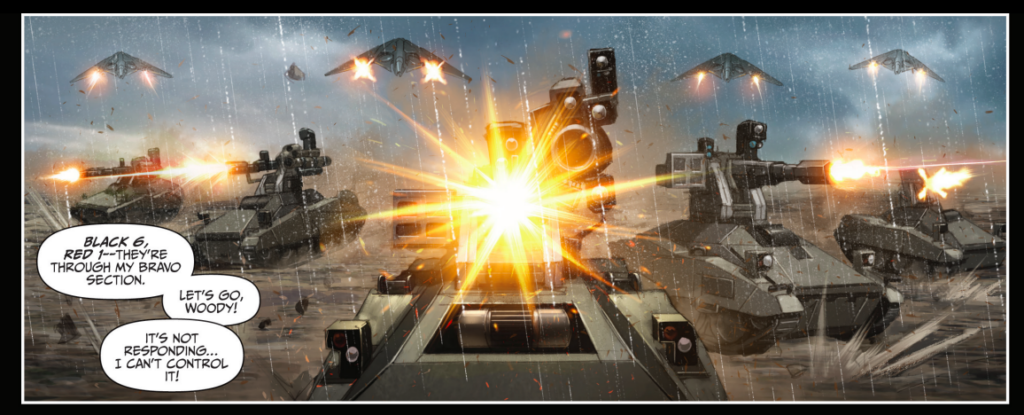
Russian drones and ground robots advance in “Silent Ruin.”
Russian drones blind US surveillance and Russian malware paralyzes US tanks so Russian robots can blow them up. That’s the lovingly illustrated scenario in a comic book about future warfare published by the Army Cyber Institute at West Point. But is it plausible? Quite possibly, several experts told us — but there are actually worse things the Russians could do to us.
Written by Arizona State University futurist Brian David Johnson and titled, with a splendid lack of subtlety, Silent Ruin, the comic doesn’t reflect any official Army or US government position. Instead, it’s part of a series of “science fiction prototypes” meant to get people thinking in and out of the armed forces.
Silent Ruin – Army Cyber Institute by nelson during on Scribd
Silent Ruin opens with a hypothetical crisis when the former Soviet territory of Moldova seeks to reunite with NATO member Romania. (In real life, Russia already has troops in part of Moldova, the secessionist mini-state of Transnistria, but the map in Silent Ruin suggests this future Russia has also occupied western Ukraine).

Army M1 Abrams tank with a trial installation of the Israeli-made Trophy Active Protection System (APS)
Russian drones neutralize their NATO counterparts with electronic warfare, blinding the Western forces and forcing them to scout the border area with manned M1 Abrams tanks. The M1s’ sensors, fire controls, and even steering are soon hacked, leaving them easy prey for Russian unmanned ground vehicles.
Inevitably in a ten-page comic book, the story is simplified. It’s not clear what happened to all of NATO’s other reconnaissance assets, from high altitude drones to manned aircraft to satellites, although cyber/electronic warfare, anti-aircraft missiles, and anti-satellite weapons could conceivably compromise all of them. The NATO tankers also seem to have forgotten every tactical lesson since 1939, leaving them vulnerable to the relatively crude robots depicted: They don’t open their hatches to look around and they advance without infantry support (except two guys in exoskeletons in the corner of one panel). But the comic is certainly thought-provoking, which is the purpose.
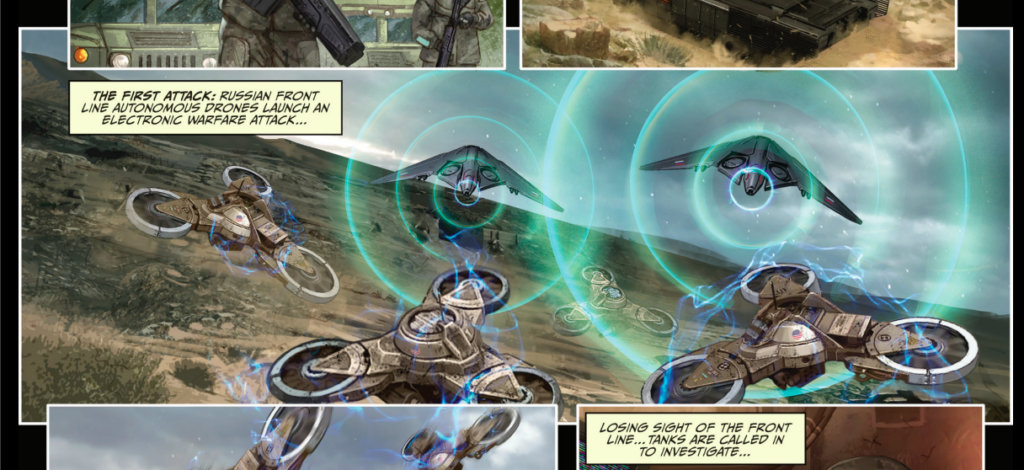
Russian drones jam NATO ones in “Silent Ruin”
The Robots Are Coming
“We will face unmanned systems. We’re already facing some, and it’s just going to keep coming,” said Rickey Smith, a retired Army colonel who’s now a senior civilian at Training & Doctrine Command (TRADOC). “But the US is not behind yet.”
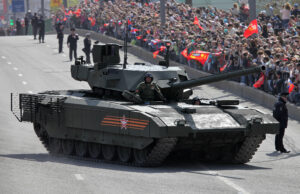
Russia’s new T-14 Armata tank (a manned vehicle) on parade in Moscow.
Army Chief of Staff Mark Milley is enthusiastic about ground robots. His hand-picked director for future armored vehicles, Brig. Gen. David Lesperance, has laid out an ambitious timeline for prototyping new unmanned and “optionally manned” vehicles starting next year. But Army officials expect at least the early models will need humans steering and aiming for them via remote control.
So first generation combat robots will probably not be high performance war machines comparable to manned M1 tanks, but rather expendable cannon fodder. The robots will scout ahead, setting off mines and ambushes, and they’ll flush out targets for humans to pick off — missions which don’t require a high level of artificial intelligence. “Maybe the opening salvo, the opening move is to flood them with as many unmanned systems as you can get,” Smith told me. “Even if they’re not that great, every time the enemy takes one out, they’re probably giving away their position….That cat and mouse will continue; unmanned systems just add another dimension to the complexity.”

Russian Uran-9 armed unmanned ground vehicle
What about the Russians? They’re investing enthusiastically in unmanned ground vehicles (UGVs), in part to offset their declining population, but their robots still fall far short of science fiction, said CNA analyst Samuel Bendett, who brought the comic to my attention in the first place.
“Russians are years away from developing UGVs that can go up against Abrams tanks,” Bendett told me. “Most of the armaments that such UGVs have is 30mm or less in caliber” — compared to 120 mm and higher for tank-mounted cannon — “along with standard anti-tank weapons” such as guided missiles — which the latest Active Protection Systems can shoot down.
As for the whole scenario, “it may be plausible,” Bendett said. “Electronic warfare is a growing component of the Russian force structure, and aided with AI (artificial intelligence), it can indeed deliver a crippling punch.” In real life, Russia is working on concepts of operation to incorporate manned and unmanned vehicles, physical weapons and cyber/electronic warfare, he told me. “It’s too early to contemplate what that would look like, although the way its described (in the comic) — EW/cyber attack followed by unmanned assets on a kamikaze mission to destroy as much Western hardware as possible — is certainly a plausible scenario at this point.”
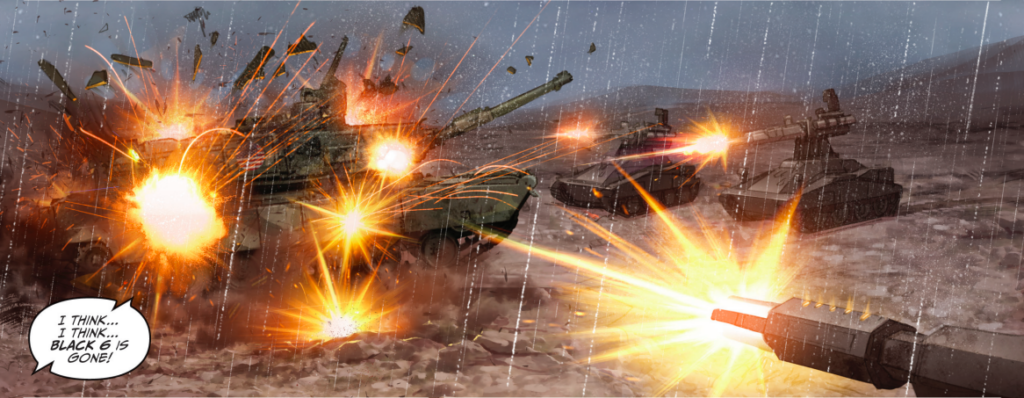
Russian ground robots destroy an American M1 Abrams tank in “Silent Ruin”
Easier Targets
“Is this possible? Probably,” one retired Army officer told me. “Are the Russians trying to figure out how to disable all the M1s so they can run over us with their robots? I hope that’s where they’re spending their time.”
There are other things the Russians could do with less effort and inflict more damage, said the retired officer, who asked to remain anonymous. “If I was going to use cyber, it wouldn’t be to disable a bunch of M1 tanks,” the officer said. “It’d be to disable the ability for us to deploy so they never got there with M1s. If you really want to hurt us, take all German rail scheduling offline for a week.”
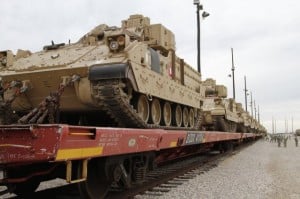
Bradley armored vehicles from the 1st Cavalry Division shipping out for a deployment to Eastern Europe.
“Focus on shutting down the rail network in eastern Europe and the oil and gas lines,” the officer said. Those are much easier targets for Russian hackers, since they’re civilian infrastructure constantly connected to the internet, as opposed to military vehicles linked only to secure networks. Shutting them off is also useful in a wide range of situations, from punishing unfriendly governments in peacetime to disrupting mobilization in wartime. Shutting down an M1 tank is really only useful if you’re planning an immediate ground attack then and there, before the US can fix it.
We know from attacks on the power grid in Ukraine and the US that “they’re perfectly capable of doing these attacks on vulnerabilities in critical infrastructure,” the officer said. “This is something we need to be aware of and shield against.”
That said, the officer acknowledged, “this is a cool graphic novel.”
Subscribe to our newsletter
Promotions, new products and sales. Directly to your inbox.
